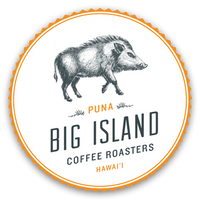Meet our Natural Ka’u Maragogipe, a super specialty and super fruity “elephant bean” coffee.
This medium-light roast has a range of complex fruit notes that give it both brightness and depth. It’s also mainly composed of beans of the Maragogipe variety, which is one of our all-time favorites – both to harvest and to drink.
But alongside Maragogipe beans, this lush and juicy blend also includes some Pacamara and Maracaturra beans. But what makes it so special? And why is this coffee different from others we offer? Read on to learn more!

Where does our Natural Ka’u Maragogipe come from?
The story behind this special coffee begins on a no-spray farm located in the high hills of the Ka’u district. From the moment we first laid eyes on these plants’ plum-sized cherries, we knew this coffee would be irresistible.
While it’s primarily made up of Maragogipe – a delicious coffee variety famed for its giant coffee beans – this coffee also comprises other large bean varieties like Pacamara (a hybrid of Pacas and Maragogipe) and Maracaturra (a hybrid of Maragogipe and Caturra).
After it’s harvested, these huge coffee cherries are dried intact as a whole fruit and cured for several months. This form of natural processing gives the coffee a unique and distinctive fruit flavor. A few days before roasting, the beans are then milled, graded, and sorted into small batches.
Coffees such as this are an absolute joy to harvest. This crop, in particular, was selectively harvested, hand-crafted, and processed by our founders, Kelleigh and Brandon.
Now, once brewed, this Natural Ka’u Maragogipe coffee has a range of complex and distinctive tasting notes, including blackcurrant, pinot, hibiscus, concord grape, slate, and bergamot.

“Elephant bean” coffee?
Bean size and density are two important quality markers for coffee, and Maragogipe is classified as what we call a “large bean” variety. But what does this mean?
Well, certain coffee varieties produce cherries that are considerably larger than the average. Two of the most common large bean varieties are Pacamara and Maragogipe. Maragogipe is even sometimes known as the “elephant bean” variety – such are the size of its cherries and beans.
As well as yielding large cherries, these varieties also tend to produce very dense beans. Bean density is an important metric for grading and sorting beans in the coffee sector, as higher-density beans are usually deemed to be higher-quality, and command a higher price as a result.
You can generally tell how dense a coffee bean is by looking at its “fissure line”, which is the crack that runs down the middle of the bean. The straighter and more open the fissure line, the less dense the bean is. On the other hand, a more crooked and closed fissure line indicates higher density.
Bean density is determined by a combination of elevation, temperature, coffee variety, rainfall, and nutrient distribution. Larger beans often come from cherries that ripen and mature more slowly on the plant, which generates more complex sugars (and subsequently more diverse flavors).

What is cascara?
“Cascara” is the word for husk, peel, or skin in Spanish; in the coffee industry, we use it to refer to the dried skin of coffee cherries. However, it can also be used to refer to a beverage made by steeping those skins to create a coffee cherry tea.
When coffee is hulled and milled, the beans are separated from the skin and pulp. Historically, these have been discarded, as it was believed they didn’t have much value. However, in recent years, using the skins to brew cascara tea has become increasingly popular.
Cascara is considered to be eco friendly, as it takes a byproduct of coffee processing and turns it into an entirely new product. As well as being good for the environment, this also gives coffee farmers a chance to diversify their income.
However, while cascara comes from the coffee plant, it tastes nothing like coffee. It also contains very little caffeine – 1/4th to 1/8th the amount of brewed coffee, even if it’s steeped for a very long time.
Cascara is sweet and fruity, with notes of rose hip, hibiscus, cherry, red current, mango, and even tobacco. Like many other fruit teas, it can be drunk either hot or cold. While the drink is naturally sweet, some people also add honey or sugar to bring out those sweet, fruity flavors.

Is cascara popular? And how do you make it?
Cascara is popping up on café menus around the world, but for most people, it’s still relatively unknown.
However, coffee farmers in Yemen and Ethiopia have been making cascara for centuries. Some research even suggests that cascara was brewed before coffee.
However, while it could be described as an intersection between coffee and tea, it can’t really be classified as either. Cascara is not technically considered a coffee beverage because it isn’t made with the coffee bean itself. Additionally, since it comes from the Coffea genus and is not a product of the Camellia sinensis plant, it’s not classified as a “true” tea either.
As it’s still fairly new to many people, there is no standard way to brew cascara. Traditionally, farmers in Yemen and Ethiopia prepare cascara by steeping the dried cherry skin in hot water, just as one would brew any other type of tea. However, there’s plenty of room to experiment – you could brew it cold and serve it as an iced tea, for instance.

Thanks to the unique blend of these dense “elephant beans” and the natural processing method, our Natural Ka’u Maragogipe coffee is comfortably one of our most special and unconventional products. It’s a delicious and exquisite specialty coffee with a deep, complex, and fruity cup profile.
Give it a try, if you haven’t already – you might find that it becomes your new favorite coffee!




